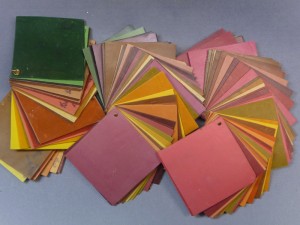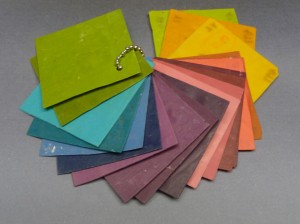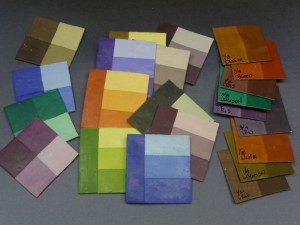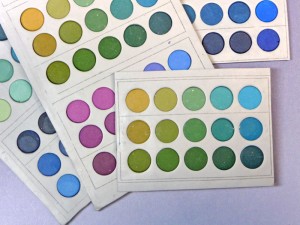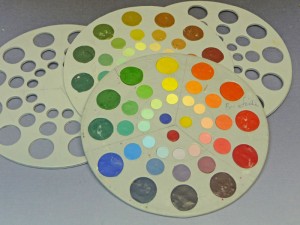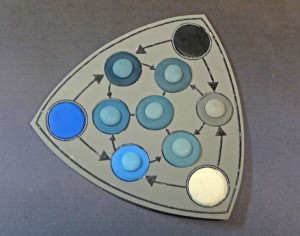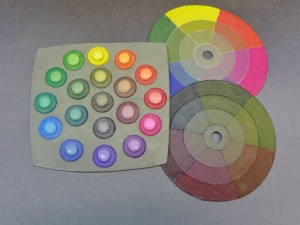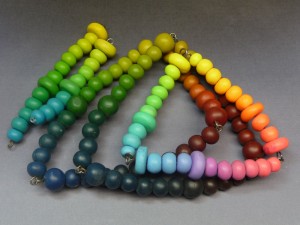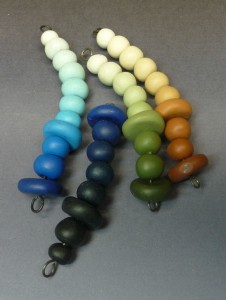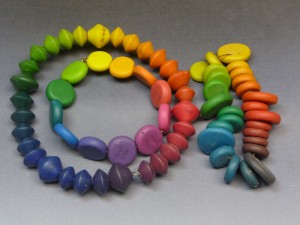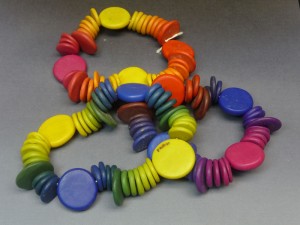Color Scales and Documenting Mixes (p.70)
I recommend watching my videos before diving into making color scales and color scale triangles.
Taking some time to make and document color mixes is the best way to learn how to mix colors instinctively. Playing scales on the piano trains the ear, making color mixes trains the eye. Color scales are my favorite way to record my color mixes but I encourage you to come up with your own system for keeping track of your color mixing experiments. Here are a few ideas from my studio drawers to get you started.
Color Swatches
I started documenting my mixes with 2″ x 2″ swatches and ended up making a series of fan decks with two primary mixes for all the Fimo primaries. The top photo shows the Carmine, Burgundy, and Red Fimo fan decks I made by mixing the reds to yellows and to the complementary green. After baking the swatches, I wrote the formula on the back, drilled holes in the corners and used a head-pin to hinge the swatches into fan decks. The second photo shows the Fimo swatches that I used as the palette for the Fable Vessel series. The third photo shows a collection of the different types of swatches I’ve used over the years to document colors mixed with white. The first batch is Fimo, the second is Premo, the third is Premo using the Watercolor Technique. I keep these swatches loose and stored in wooden boxes so I can pull them out when I need color inspiration.
Color Templates
Before I switched to color scales, I sometimes documented mixes by inserting the colors into holes punched in templates made from gray clay. To get the lines and the patterns for cutting holes, I drew up the templates on the computer and made copies to transfer the design to the raw clay. I then cut out the holes with a circle cutter and baked the template before adding the color mixes. This technique proved to be way too labor intensive for me . . . but it might be right up your alley.
Color Scales
Color Scales came about when I needed an easier way to organize my mixes and see all the possibilities at a glance. The top photo with the round beads shows some of the first color scales I ever made. They were made in Fimo around 1994 and each scale was strung on wire so that I could mix and match them for different primary combinations. I ended up with over 40 two-color scales that could be interchanged to get the palette I wanted. The second photo shows some of the Fimo color scales going to white and black. The third photo shows a few bead strands that I made for project palettes; the bicone bead strand was made with Fimo, the other two are Premo. The last photo shows three bead strands that I made to document double primaries in Premo. The orange scales were made from Cad Yellow, Zinc Yellow, Cad Red and Fuchsia. For the green scales, I used Cobalt, Ultramarine, Cad Yellow and Zinc Yellow. The purple scales used Cad Red, Fuchsia, Cobalt and Ultramarie.
As you can see, I never bothered to come up with one perfect way to keep track of all the test mixing I do in the studio. The important thing is to do it – document it if you can – and move on to the next project!

